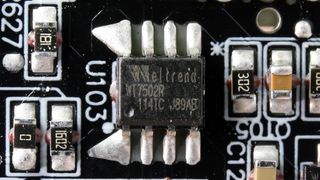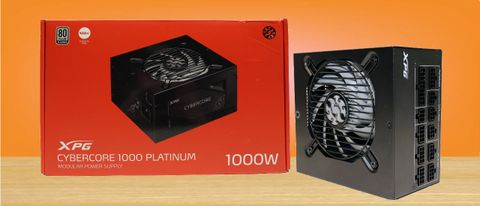Tom's Hardware Verdict
The XPG Cybercore 1000 has top build quality, and it is also equipped with one of the best fans we have seen in PSUs. It will soon get an upgrade with a 12+4 pin connector.
Pros
- +
+ Full power at 47 degrees Celsius
- +
+ High build quality
- +
+ Top-notch cooling fan
- +
+ Tight enough load regulation on the minor rails
- +
+ Long hold-up time
- +
+ Not noisy
- +
+ Low inrush current with 115V
- +
+ Fully modular
- +
+ Loads of connectors
- +
+ Long cables
- +
+ Adequate distance between the peripheral connectors
- +
+ Compatible with the alternative lower power modes
- +
+ Compact dimensions
- +
+ 10-year warranty
Cons
- -
Lacks a 12+4 pin connector (for the moment)
- -
Overall performance needs a boost
- -
Not so tight load regulation at 12V
- -
High inrush current with 230V
- -
Mediocre transient response at 3.3V
- -
Efficiency at light loads should be higher
Why you can trust Tom's Hardware
The XPG Cybercore might be left a little behind by the EVGA (1000 P6) and Asus (Rog Thor II 1000) competitors, but it features extra high build quality and uses one of the best fans we have seen in a PSU so far. Moreover, it has compact dimensions and loads of connectors, which don't include a 12+4 pin, though, and its transient response at 12V is good. Thanks to its semi-digital platform, it will be easily upgraded to meet the ATX12V v3.0 requirements, and soon enough, it will also have a 12+4 pin connector to support the RTX 3090 Ti and several upcoming GPUs. Its upcoming version looks promising and will probably earn a place in our best PSUs article.
XPG takes power seriously since it has people with vast experience in power supplies in its arsenal. This time, it released two high-power PSUs, with 1000 W and 1300 W max power, and in today's review, we will evaluate the Cybercore 1000. For the Cybercore line, XPG teamed with Nidec, one of the best fan manufacturers, so the members of the line use top-notch fans (XPG Vento Pro 120 PWM). In PSUs, two parts are crucial: the electrolytic capacitors and the cooling fan. Usually, the latter has a problem keeping up, especially under harsh conditions, and if the cooling fan stops working, naturally, everything else will do the same after a while.
So a good fan plays a significant role in a PSU's longevity. The problem is that good fans cost a lot, so in most cases, you can see high-end PSUs using mid-level fans while the lower-end PSUs come with sleeve-bearing fans, which are not suitable for serious workloads.












Besides a top-quality fan, the Cybercore 1000 uses a fully modular cable design, which in this version doesn't include a 12+4 pin connector. Nonetheless, XPG informed me that they are already working on an updated version that will consist of this connector. Our best guess is that it will incorporate the rest changes required by the newest ATX spec, including improved response to transient loads.








Specifications
| Manufacturer (OEM) | CWT |
| Max. DC Output | 1000W |
| Efficiency | 80 PLUS Platinum, Cybenetics Platinum (89-91%) |
| Noise | Cybenetics A- (25-30 dB[A]) |
| Modular | ✓ (fully) |
| Intel C6/C7 Power State Support | ✓ |
| Operating Temperature (Continuous Full Load) | 0 - 40°C |
| Over Voltage Protection | ✓ |
| Under Voltage Protection | ✓ |
| Over Power Protection | ✓ |
| Over Current (+12V) Protection | ✓ |
| Over Temperature Protection | ✓ |
| Short Circuit Protection | ✓ |
| Surge Protection | ✓ |
| Inrush Current Protection | ✓ |
| Fan Failure Protection | ✗ |
| No Load Operation | ✓ |
| Cooling | 120mm Double Ball Bearing Fan (D1225C12B6ZPAC7) |
| Semi-Passive Operation | ✓ |
| Dimensions (W x H x D) | 150 x 85 x 160mm |
| Weight | 1.94 kg (4.28 lb) |
| Form Factor | ATX12V v2.52, EPS 2.92 |
| Warranty | 10 Years |
Power Specifications
| Rail | Row 0 - Cell 1 | 3.3V | 5V | 12V | 5VSB | -12V |
| Max. Power | Amps | 22 | 22 | 83.33 | 3 | 0.3 |
| Row 2 - Cell 0 | Watts | Row 2 - Cell 2 | 120 | 1000 | 15 | 3.6 |
| Total Max. Power (W) | Row 3 - Cell 1 | Row 3 - Cell 2 | 1000 | Row 3 - Cell 4 | Row 3 - Cell 5 | Row 3 - Cell 6 |
Cables and Connectors
| Description | Cable Count | Connector Count (Total) | Gauge | In Cable Capacitors |
|---|---|---|---|---|
| ATX connector 20+4 pin (750mm) | 1 | 1 | 16-18AWG | No |
| 4+4 pin EPS12V (750mm) | 2 | 2 | 16AWG | No |
| 6+2 pin PCIe (750mm) | 2 | 2 | 16AWG | No |
| 6+2 pin PCIe (750mm+150mm) | 2 | 4 | 16-18AWG | No |
| SATA (600mm+150mm+150mm+150mm) | 3 | 12 | 18AWG | No |
| 4-pin Molex (600mm+150mm+150mm+150mm) | 1 | 4 | 18AWG | No |
| FDD Adapter (150mm) | 1 | 1 | 20AWG | No |
The release of the ATX12V v3.0 standard rendered almost all current PSUs obsolete because they lack the 12+4 pin connector, which can be found in the freshly released RTX 3090 Ti. Nonetheless, this doesn't mean that your older PSU will be useless since even Nvidia included an adapter in its recent release to provide compatibility with the 12+4 pin socket. It is not ideal to use adapters, but they allow you to continue using your old PSU if it is strong enough to support the new graphics cards.
The Cybercore 1000 comes with enough cables and connectors. It is nice to see super-long cables since these PSUs are for colossal chassis. Moreover, the distance between the peripheral connectors is ideal. Finally, there are no in-line caps, and the cables through which will pass lots of Amperes use thicker gauges. Everything is in order here. XPG did a great job!






Component Analysis
We strongly encourage you to have a look at our PSUs 101 article, which provides valuable information about PSUs and their operation, allowing you to better understand the components we're about to discuss.
| General Data | - |
| Manufacturer (OEM) | CWT |
| PCB Type | Double Sided |
| Primary Side | - |
| Transient Filter | 6x Y caps, 2x X caps, 2x CM chokes, 1x MOV |
| Inrush Protection | NTC Thermistor SCK207R0 (7 Ohm) & Relay |
| Bridge Rectifier(s) |
2x Vishay LVB2560 (600V, 25A @ 105°C)
|
| APFC MOSFETs |
2x Infineon IPA60R099P6 (600V, 24A @ 100°C, Rds(on): 0.099Ohm) &
1x Sync Power SPN5003 FET (for reduced no-load consumption) |
| APFC Boost Diode |
2x Infineon IDH08G65C6 (650V, 8A @ 145°C)
|
| Bulk Cap(s) | |
| Main Switchers |
4x Alpha & Omega AOTF29S50 (500V, 18A @ 100°C, Rds(on): 0.15Ohm)
|
|
IC Driver | |
|
APFC MCU |
1x Texas Instrument UCD3138A |
| LLC Resonant MCU |
1x Texas Instrument UCD3138A
|
| Topology |
Primary side: Semi-Digital, Interleaved PFC, Full-Bridge & LLC converter
Secondary side: Synchronous Rectification & DC-DC converters |
| Secondary Side | - |
| +12V MOSFETs | 8x Infineon BSC016N06NS (60V, 143A @ 100°C, Rds(on): 1.6mOhm) |
| 5V & 3.3V | DC-DC Converters |
| Filtering Capacitors |
Electrolytic: 4x Nippon Chemi-Con (105°C,W), 2x Nippon Chemi-Con (2-5,000h @ 105°C, KZE), 4x Nippon Chemi-Con (4-10,000h @ 105°C, KY), 2x Rubycon (6-10,000h @ 105°C, ZLH), 1x Rubycon (4-10,000h @ 105°C, YXJ), 1x Rubycon (4-10,000h @ 105°C, YXF) |
| Supervisor IC | Weltrend WT7502R (OVP, UVP, SCP, PG) |
| Fan Model | XPG Nidec D1225C12B6ZPAC7 (120mm, 12V, 0.13A, Double Ball Bearing Fan) |
| 5VSB Circuit | - |
| Rectifier |
1x PS1045L (45V, 10A) SBR &
1x IPS ISD04N65A FET |
| Standby PWM Controller | On-Bright OB5282 |




This is a slightly modified CST platform provided by Channel Well Technology. It uses a double-sided PCB, which is more suitable for high-power PSUs, and its build quality is top. The same goes for the parts used, including Infineon and Alpha & Omega FETs, Texas Instruments controllers, Japanese caps, and a Nidec fan.
Nidec is one of the best fan manufacturers, but its products are super expensive. The platform uses a semi-digital design with an interleaved APFC, a full-bridge topology, and an LLC resonant converter on the primary side. We meet the usual stuff, synchronous rectification, and a pair of DC-DC converters on the secondary side.






The transient/EMI filter is complete. The NTC thermistor, handling large inrush currents, is supported by a bypass relay to cool down fast once the PSU is in operation and not waste energy.


The pair of bridge rectifiers can handle up to 50 Amperes, which is more than enough for this PSU.





The interleaved APFC has two converters operating parallel, with a phase difference. This type of APFC allows for lower input and output current ripple, and it also offers lower conduction losses and higher efficiency. An MCU controls the interleaved APFC.




Four Alpha & Omega FETs are the primary switching FETs installed into a full-bridge topology. They are driven by an MCU and a pair of Silicon Labs Si8233BD ICs.


The control board hosting the Texas Instrument UCD3138A MCU and the pair of Silicon Labs Si8233BD drivers.


Eight Infineon BSC016N06NS FETs regulate the 12V rail. They are installed on a board close to the main transformer to minimize energy losses.



The electrolytic caps are of good quality, belonging to good series of Japanese manufacturers. Lots of polymer caps are also used for ripple filtering purposes.



The standby PWM controller is an On-Bright OB5282 IC. The rectifier on the primary side is an IPS ISD04N65A FET, and on the secondary side, a PS1045L (45V, 10A) SBR.



We find several bus bars on the modular board for power transfer use and several polymer caps.

The main supervisor IC is a Weltrend WT7502R.



Soldering quality is great.


The 120mm Nidec fan uses double-ball bearings, which have a high tolerance to increased operating temperatures. This is an expensive fan, and our only remark is that they could use a larger fan, with a 140mm diameter, to lower output noise.
MORE: Best Power Supplies
MORE: How We Test Power Supplies
MORE: All Power Supply Content
Current page: Specifications and Part Analysis
Next Page Load Regulation, Hold-Up Time, Inrush and Leakage Current, Efficiency and NoiseAris Mpitziopoulos is a Contributing Editor at Tom's Hardware US, covering PSUs.
